What Is CCPM on an RC Helicopter, Why it's Important & Swashplate Types
by John Salt - Updated April 2025
What exactly is CCPM? Is it a gimmick, a nonsensical RC helicopter marketing buzz word like "6 axis gyro" (don’t get me started on that one)?
I am glad to say no, it's a primary and very necessary function of all collective pitch RC helicopter swashplate control.
Before I get ahead of myself, I better explain what C-C-P-M stands for and what it does... the necessity of it will then become obvious.
It is an acronym that stands for... Cyclic-Collective-Pitch-Mixing. This feature is only found on RC helicopters with collective pitch (as the name suggests), it doesn’t apply to fixed pitch helicopters.
I should mention that you will see collective cyclic pitch mixing referred to as electronic (eCCPM) or mechanical (mCCPM) mixing.
Seeing that most CCPM swashplate types these days function by electronic mixing, that is what I'll primarily be covering; but please remember all collective pitch RC helicopters use a form of CCPM (either mechanical or electronic).
Here's a very short video demonstrating CCPM to help you visualize how the servos of a collective pitch RC helicopter are "mixed" to move the swashplate in its 3 directions:
- Up/Down: Collective
- Left/Right: Cyclic Roll / Aileron
- Forward/Backward: Cyclic Pitch / Elevator
CCPM Mechanical Mixing
Until eCCPM came around, we only called our mixing method mechanical. A way to control the swashplate's collective pitch movement and cyclic pitch & roll movement by means of a complex series of linkages and levers from the servos up to the swashplate. Most systems consisted of mixing the collective pitch servo movements with the left/right cyclic roll servo and the fore/aft cyclic pitch servo movements to the swashplate.
The disadvantages with mechanical mixing comes from all the linkages and levers; there is always a bit of slop and increased drag in them. This can be minimized on higher end RC helicopters by using ball bearings on all these lever pivot points instead of simple bushings; but even bearings have radial play and it's additive through the system.
The more bearings used, the more cost and mass, and with more mass, comes increased inertia of all these moving parts. Parts count and complexity are also up substantially with a mechanical mixed layout as you can see below on my Bergen Intrepid.
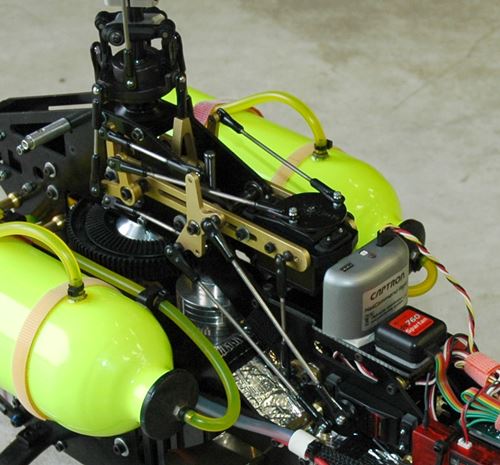 Complex Mechanical CCPM Component Layout
Complex Mechanical CCPM Component LayoutBergen RC by the way had one of the nicest mechanical mixed systems going in my opinion - they're a mechanical art form .
Perhaps the single biggest disadvantage with mechanical CCPM is it puts a lot of strain on the collective pitch servo. This single servo not only has to move the entire swashpate up and down to change the collective pitch angle of the main rotor blades, it has to overcome all the friction and increased inertia associated with all the linkages. It's not uncommon at all to use a substantially, higher torque servo for the collective than the other two cyclic servos.
Mechanical mixing does have a couple advantages, such as no complicated swashplate setup to avoid servo variation & interaction issues; and because the servos are typically mounted in a servo tray and not directly in the frame, they are exposed to less vibration which on a gas or nitro powered heli does have some merit.
These are rather minimal advantages given the more impactful disadvantages, thus it's no surprise that mechanical CCPM is seldom used anymore. Certainly never used on any of the high performance machines currently on the market.
Electronic CCPM
Electronic Cyclic-collective-pitch-mixing is only possible because of advances in computerized RC radio technology and/or FBL systems. The mixing functions are all done electronically within the RC radio and the servos all interact and move accordingly. The other method of electronic mixing as I just mentioned is done internally by the flybarless stabilization system. Not all flybarless units support "internal mixing", but most do.
Now three or sometimes four servos can be hooked directly to the swashplate without any complex mixing linkages. This of course simplifies the helicopter, reduces the number of parts, weight, and cost. There is less slop in the system and this provides very precise control of your helicopter.
As seen below with a standard 120° electronically mixed CCPM layout compared to the mechanical mixed one above on the Intrepid; there are substantially fewer parts, linkages, and bearings; saving substantial weight, cost, linkage drag, and assembly/maintenance time.
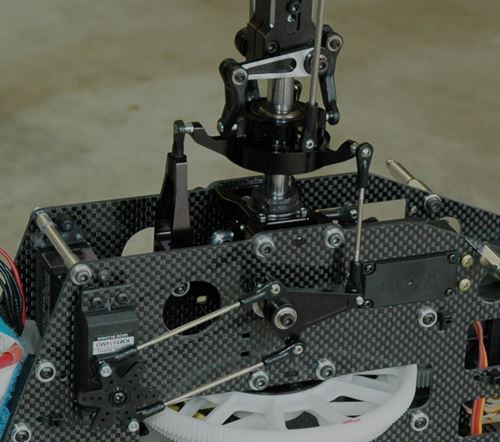 Simplifed Electronic CCPM Component Layout Using Bell Cranks
Simplifed Electronic CCPM Component Layout Using Bell CranksThe problem of excessive strain on the collective pitch servo is also gone. Not just because all the linkages are gone, but also because the total collective workload is now shared by the three CCPM servos.
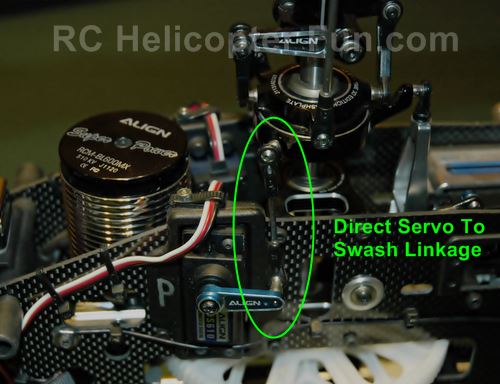 Direct Linkages Further Simplifing Electronic Mixing
Direct Linkages Further Simplifing Electronic MixingGoing direct simplifies electronic mixing even further. As seen in the above photo, there are no Bell Cranks. The servos are connected direct to the swahsplate by single pushrods right from the servo arm, up to the swash.
This is as simple and direct as electronic mixing gets. Parts count is down even further, as is weight, cost, play/movement, and linkage drag. Perfect for high performance 3D flying.
There is one disadvantage however going this direct.
When you crash or have a blade strike; there is more impact force going back to the servo/s and it's much more likely you will strip out servo gears (yes, even if they are metal). When you have Bell Cranks, there are more "mechanical fuse" points that can absorb some of the impact energy from getting back into the servos. I go into more detail about this issue on my RC Servo page.
CCPM MIXING/SWASHPLATE TYPES
There are essentially nine (9) main different mixing/swashplate types available on most of today's collective pitch RC helicopters and they are all categorized/named by the placement and the number of servo inputs to the swashplate as seen in a 360° circle around the swashplate.
The first four I have listed are the most common, the remaining five are seldom seen but they are out there. Almost all radios with helicopter software and/or flybarless systems will support the first 3 mainly used swashplate mixing types, and generally only higher end/advanced radios or flybarless systems will support the others.
1. 90° Normal / H1 Swash Type
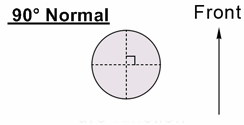
This is the standard default setting for most if not all mechanical mixing swashplate types. Likewise, if your flybarless unit performs the electronic CCPM internally (almost all do), you would select a 90° Normal / H1 swash type on the radio.
Basically a 90° Normal mix/swashplate type selection separates the 3 axis of CCPM swashplate movement to the 3 separate servos that control lift (collective pitch servo), aileron (cyclic roll servo), and elevator (cyclic pitch servo).
90° Normal mixing in other words is what any normal RC radio will produce - a standard radio output with no channel mixing whatsoever.
2. 120° 3 Servo / H3-120 Swash Type
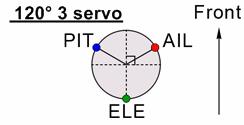
The most commonly used electronic swash mixing type these days uses three servos that are equally placed at 120° intervals around the swashplate with the elevator input at the front or back of the swashplate, and the aileron & pitch inputs on the left and right sides. The pitch, aileron, and elevator channels are electronically mixed to create the proper CCPM interactions.
The only slight issue with this mixing/swashplate type is the left and right movement of the swashplate is a fraction faster than the fore and aft movement because of the overall geometry. This will cause some slight variations in control as the servos catch up to one another to create the proper swashplate angle.
I should point out that this variation gets worse at the extreme ends of swashplate travel and for most of us average fliers is totally and completely undetectable. Moreover, most good flybarless stabilization systems absorb or filter out these minor speed induced variations.
3. 140° 3 Servo / H3-140 Swash Type
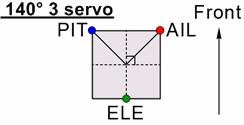
To cure the slight speed variation issue that occurs on 120° swash types, some RC helicopter manufacturers (JR for example) offer 140° CCPM.
With 140°mixing, the swashplate geometry is evened out between the side servos and the front or back servo. This gives more consistent speed interactions between all 3 CCPM servos and reduces small amounts of variation.
4. 90° 4 Servo / H4-00 Swash Type
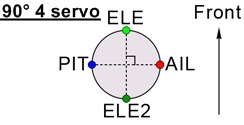
This is a somewhat uncommon configuration but some larger scale RC helicopter mechanics such as Vario use it and Velos used it on their 880. 4 Servos are used on each quarter section of the swashplate providing maximum swashplate power.
5. 90° 3 Servo / H3-90 Swash Type
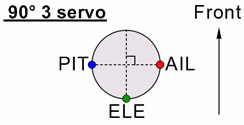
This is a variation on the H4-00, eliminating one of the elevator servos; used on some Vario scale mechanics.
Like the H4-00 two of the swashplate servos (aileron & pitch) are placed at 9 and 3 o-clock. The third servo (elevator) is placed at either 12 or 6 o-clock.
If your radio or flybarless system doesn't support this swash type, but it supports the previous 90° 4 Servo / H4-00 type, you can use the 4 servo H4-00 type, you simply won't be using the 2nd elevator servo output.
6. 90° 4 Servo X / H4-45 Swash Type
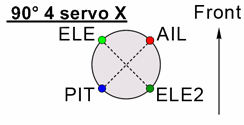
This is a variation to the more common 90° 4 Servo where the swashplate inputs are not at 12,3,6,&9 o-clock but instead shifted 45° to aid in servo placement in some mechanical layouts. It's very rare but a few radios and flybarless systems will support this mixing type.
7. 120°X 3 Servo Side / H3-120 Side Swash Type
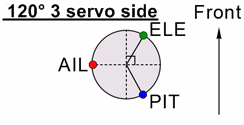
Another very rare and strange configuration. This basically rotates the much more common 120° 3 Servo layout out so the aileron servo is now directly on one of the sides and the pitch and elevator are phased 120 degrees out.
8. 135° 3 Servo / H3-135 Swash Type
135° 3 servo electronic mixing is a slight geometry variation to the more common 140° mixing. This mixing type improves the geometry on some specific helicopter swashplate and servo mechanical layouts to again combat geometry/speed interaction variations.
9. 180° 2 Servo / H2-180 Swash Type
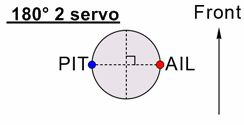
I honestly have no idea how this can even work nor have I ever seen or heard of any collective pitch RC helicopter that uses it but some high end radios do have this swash mixing type listed so there must be some out there? As you can see in the photo of the layout, how is there any elevator (cyclic pitch) movement?
I suppose it could be used on a collective pitch tandem rotor where the fore and aft pitch control would be controlled by lift differential between the front and back rotor. Perhaps the elevator output would be plugged into some sort of lift mix control unit? Just a guess...
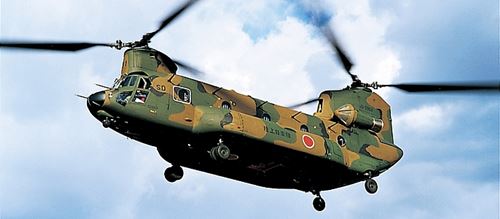
Keep all this in mind when you are getting your Helicopter, Radio or Flybarless sytem. Don’t get a helicopter that has a specific electronic Cyclic-Collective-Pitch-Mixing type if your RC radio or flybarless unit doesn’t support it.
Again, you will be covered for the majority of collective pitch RC helicopters if you have Normal 90°, 120° 3 servo, and 140° 3 servo; and for a little large bird reassurance icing on the cake, 90° 4 servo mixing/swashplate types on your radio and/or flybarless system.
If you wanted to learn more about 120/135/140 CCPM swashplate setup, I have an e-book that goes through the entire process. Just click on that link or the image of the e-book if you are interested in it.
I hope that clears up any “Mix-ups” you might have had. Sorry - bad humor, just couldn’t resist.









